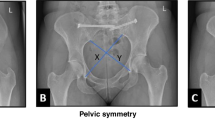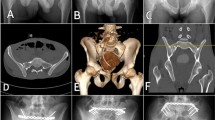Abstract
Background
Pelvic fractures represent major injury. Women of childbearing age who have sustained pelvic fractures question whether they can have children and what type of delivery will be possible.
Questions/purposes
(1) Genitourinary and sexual dysfunction can be expected in women of child bearing age with pelvic fractures; (2) functional outcomes of women with pelvic fractures are related to fracture pattern and whether they were treated with surgery; (3) women treated nonoperatively and those treated operatively with fixation sparing the pubic symphysis can deliver children vaginally.
Methods
We retrospectively reviewed 71 women with pelvic fractures. Forty-one had stable fractures and 25 had unstable fractures; five radiographs could not be located to classify fractures. Forty women had surgery for their pelvic fractures.
Results
Thirty-five women (49%) had one or more genitourinary complaints; 26 women (38%) had pain with sexual intercourse. The overall SF-12 score and physical and mental health component were lower in women who had surgical fixation of their pelvic fracture. Overall SF-12 scores were similar in women who did and did not have children after their pelvic fracture. Twenty-six women had children after their pelvic fracture: 10 (38%) delivered vaginally; 16 (62%) had a cesarean section. Four (40%) of the women who delivered vaginally had surgical fixation of their fracture, including rami screws and/or sacroiliac screws.
Conclusions
Our data suggest the cesarean section rate is still more than double standard norms, but vaginal delivery after pelvic fracture, even in those treated with surgical fixation sparing the pubic symphysis, is possible.
Level of Evidence
Level III, therapeutic study. See the Guidelines for Authors for a complete description of levels of evidence.
Similar content being viewed by others
References
Burgess AR, Eastridge BJ, Young JW, Ellison TS, Ellison PS Jr., Poka A, Bathon GH, Brumback RJ. Pelviv ring disruption: effective classification system and treatment protocols. J Trauma. 1990;30:848–856.
Copeland CE, Bosse MJ, McCarthy ML, MacKenzie EJ, Guzinski GM, Hash CS, Burgess AR. Effect of trauma and pelvic fracture on female genitourinary, sexual, and reproductive function. J Orthop Trauma. 1997;11:73–81.
Guillemette J, Fraser WD. Differences between obstetricians in caesarean section rates and the management of labour. Br J Obstet Gynaecol. 1992;99:105–108.
Holbrook TL, Hoyt DB. The impact of major trauma: quality-of-life outcomes are worse in women than in men, independent of mechanism and injury severity. J Trauma. 2004;56:284–290.
Kellam JF, Mayo K. Pelvic ring disruption. Pelvic fractures. In: Browner BD, Jupiter JJ, Levine AM, Trafton PG, eds. Skeletal Trauma. 3rd Ed. Philadelphia, PA: WB Saunders; 2003:1063.
Krishnamurthy S, Fairlie F, Cameron AD, Walker JJ, Mackenzie JR. The role of postnatal x-ray pelvimetry after caesarean section in the management of subsequent delivery. Br J Obstet Gynaecol. 1991;98:716–718.
LeFaivre KA, Padelecki JR, Starr AJ. What constitutes a Young and Burgess lateral compression I (OTA 61-B2) pelvic ring disruption? A description of computed tomography-based fracture anatomy and associated injuries. J Orthop Trauma. 2009;23:16–21.
Lev-Weisel R, Chen R, Daphna-Tekoah S, Hod M. Past traumatic events: are they a risk factor for high-risk pregnancy, delivery complications and post-partum post-traumatic symptoms? J Womens Health. 2009;18:119–125.
MacDorman MF, Menacker F, Declerq E. Cesarean births in the United States: epidemiology, trends and outcomes. Clin Perinatol. 2008;35:293–307.
Madsen LV, Jensen J, Christensen ST. Parturition and pelvic fracture. Follow-up of 34 obstetric patients with a history of pelvic fracture. Acta Obstet Gynecol Scand. 1983;62:617–620.
McCarthy ML, Mackenzie EJ, Bosse MJ, Copeland CE, Hash CS, Burgess AR. Functional status following orthopaedic trauma in young women. J Trauma. 1995;39:828–837.
Mulla N. Fracture of the pelvis in pregnancy. Am J Obstet Gynecol. 1957;74:246–250.
Sathy AK, Starr AJ, Smith WR, Elliot A, Agudelo J, Reinert CM, Minei JP. The effect of pelvic fracture on mortality after trauma: an analysis of 63,000 trauma patients. J Bone Joint Surg Am; 2009:91;2803–2810.
Schuman W. Fractured pelvis in obstetrics (with report of cases). Am J Obstet Gynecol. 1932;23:103–107.
Speer DP, Peltier LF. Pelvic fractures and pregnancy. J Trauma. 1972;12:474–480.
Starr AJ, Smith WR, Frawley WH, Borer DS, Morgan SJ, Reinert CM, Mendoza-Welch M. Symptoms of posttraumatic stress disorder after orthopaedic trauma. J Bone Joint Surg Am. 2004;86:1115–1121.
Yang YT, Mello MM, Subramanian SV, Studdert DM. Relationship between malpractice litigation pressure and rates of cesarean section and vaginal birth after cesarean section. Med Care. 2009;47:234–242.
Zhou SR. Fracture-dislocation of pelvis in the adult female: clinical analysis of 105 cases. Zhonga Wai Ke Za Zhi. 1989;27:479–481, 509–510.
Acknowledgments
We thank Heidi Israel, PhD, St Louis University Department of Orthopaedic Surgery, for providing the statistics for this study.
Author information
Authors and Affiliations
Corresponding author
Additional information
The author’s institutions (LKC, University of Texas-Southwestern Medical Center and St Louis University; JB, University of Mississippi) received research support for this study from the Foundation for Orthopaedic Trauma and the Ruth Jackson Orthopaedic Society Zimmer Research Award.
Each author certifies that her institution approved the human protocol for this investigation, that all investigations were conducted in conformity with ethical principles of research, and that informed consent for participation in the study was obtained.
This work was performed at the University of Texas-Southwestern Medical Center, Dallas, TX, USA, and the University of Mississippi Medical Center, Jackson, MS, USA.
Appendices
Appendix 1 Information/Consent Packet Contents
-
1.
Letter Explaining Study
-
2.
HIPPA Form and Consent
-
3.
Consent
-
4.
Release Form to Obstetrician (if patient had child after pelvic fracture)
-
5.
Questionnaire (see Appendix 2)
-
6.
SF 12
Appendix 2
Pelvic Fractures and Childbirth



Appendix 3
Parturition and Pelvic Fractures

About this article
Cite this article
Cannada, L.K., Barr, J. Pelvic Fractures in Women of Childbearing Age. Clin Orthop Relat Res 468, 1781–1789 (2010). https://doi.org/10.1007/s11999-010-1289-5
Published:
Issue Date:
DOI: https://doi.org/10.1007/s11999-010-1289-5




